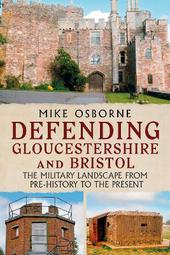
|
Defending Gloucestershire and Bristol
Paperback / softback
Main Details
| Title |
Defending Gloucestershire and Bristol
|
| Authors and Contributors |
By (author) Mike Osborne
|
| Physical Properties |
| Format:Paperback / softback | | Pages:256 | | Dimensions(mm): Height 234,Width 156 |
|
| ISBN/Barcode |
9781781558898
|
| Audience | |
|---|
| Illustrations |
103 colour illustrations, 1 black and white illustration, and 15 maps
|
|
Publishing Details |
| Publisher |
Fonthill Media Ltd
|
| Imprint |
Fonthill Media Ltd
|
| NZ Release Date |
22 December 2022 |
| Publication Country |
United Kingdom
|
Description
Gloucestershire's strategic location straddling the Severn is reinforced by Bristol's importance as a port. The Forest of Dean and the Cotswolds are densely populated by prehistoric hillforts and Gloucester, Cirencester and Winchcombe were important throughout the Roman and Anglo-Saxon periods. The Normans built substantial castles at Bristol, Gloucester and Berkeley, scene of Edward II's murder, with many more of earth and timber. Many figured in the conflicts between rival factions culminating in the Battle of Tewkesbury. In the Civil War, Bristol underwent two sieges and Gloucester another and one of the last battles, at Stow, followed continuous skirmishing. The next centuries saw volunteer forces established, formalised by the State by the end of Victoria's reign, to counter threats external and internal. A nascent aircraft industry would develop into aircraft factories and airfields in the First World War with further development of training and aircraft storage facilities for the newly formed RAF during the inter-War period. Anti-invasion defences were constructed in the Second World War, but the primary effort was in logistics: bases for arriving US troops; RAF and USAAF training airfields and depots; and communications facilities. This last aspect, along with intelligence gathering, continued into the Cold War and beyond.
Author Biography
Dr Mike Osborne's interest in fortification began with childhood visits to castles and forts. It has developed over the years to include all aspects of the topic from Iron-Age hillforts to Cold War bunkers. He was a volunteer-coordinator for the Defence of Britain Project recording twentieth-century military structures. After a thirty-year-career in education he took early retirement to write, producing twenty-five books to date. Topics include: Civil War sieges and fortifications, drill halls, the Volunteer Training Corps, the best-selling Defending Britain, and a series of county surveys of defences including four titles for Fonthill and the award-winning Defending Cambridgeshire.
|